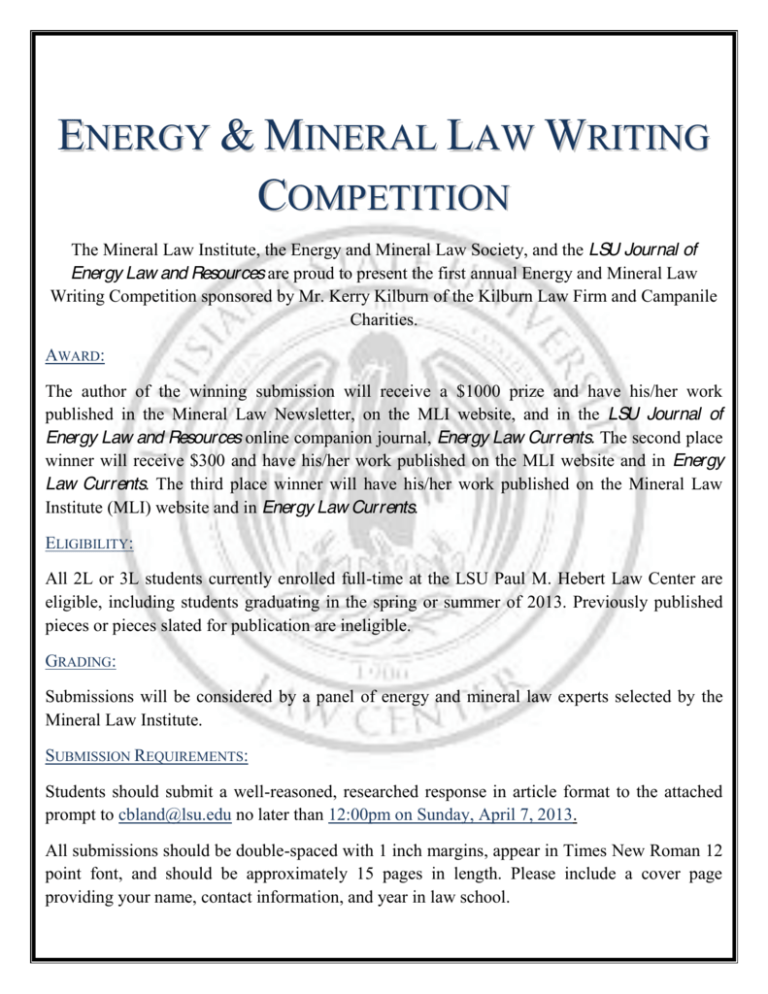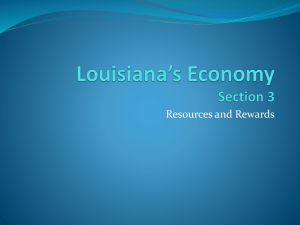& MINERAL
advertisement

ENERGY & MINERAL LAW WRITING COMPETITION The Mineral Law Institute, the Energy and Mineral Law Society, and the LSU Journal of Energy Law and Resources are proud to present the first annual Energy and Mineral Law Writing Competition sponsored by Mr. Kerry Kilburn of the Kilburn Law Firm and Campanile Charities. AWARD: The author of the winning submission will receive a $1000 prize and have his/her work published in the Mineral Law Newsletter, on the MLI website, and in the LSU Journal of Energy Law and Resources online companion journal, Energy Law Currents. The second place winner will receive $300 and have his/her work published on the MLI website and in Energy Law Currents. The third place winner will have his/her work published on the Mineral Law Institute (MLI) website and in Energy Law Currents. ELIGIBILITY: All 2L or 3L students currently enrolled full-time at the LSU Paul M. Hebert Law Center are eligible, including students graduating in the spring or summer of 2013. Previously published pieces or pieces slated for publication are ineligible. GRADING: Submissions will be considered by a panel of energy and mineral law experts selected by the Mineral Law Institute. SUBMISSION REQUIREMENTS: Students should submit a well-reasoned, researched response in article format to the attached prompt to cbland@lsu.edu no later than 12:00pm on Sunday, April 7, 2013. All submissions should be double-spaced with 1 inch margins, appear in Times New Roman 12 point font, and should be approximately 15 pages in length. Please include a cover page providing your name, contact information, and year in law school. ENERGY & MINERAL LAW WRITING COMPETITION PROMPT Article 6 of the Louisiana Mineral &RGHVWDWHVWKDW³2ZQHUVKLSRIODQGGRHVQRWLQFOXGHRZQHUVKLSRIRLOJDVDQG other minerals occurring naturally in liquid or gaseous form, or of any elements in solution, emulsion, or association with such minerals. The landowner has the exclusive right to explore and develop his property for the production of such PLQHUDOVDQGWRUHGXFHWKHPWRSRVVHVVLRQDQGRZQHUVKLS´ On a practical level, this means that unlike in most other states, mineral rights in Louisiana cannot be severed from the land itself in perpetuity. Beginning in 1922, Louisiana courts have almost universally held that the juridical QDWXUHRI³VHYHULQJ´RZQHUVKLSRIWKHPLQHUDOVLVDORQJWKHOLQHVRIDVHUYLWXGHDQGDVVXFKLVVXEMHFWWRDSUHVFULSWLYH regime of 10 years non-use. However, there is an exception to this rule. In 1938, the Louisiana legislature enacted Acts No. 68 and 151 of 1938, which made mineral reservations in certain land acquisitions by the State of Louisiana or the United States government imprescriptible. However, in order to preserve the uniformity of law on mineral rights, these Acts covered only purchases made for specific purposes. Act 68 specifically related to lands acquired for spillway or flood control under authority of the Flood Control Act. Act 151 provided generally that when land was acquired by the United States, WKH 6WDWH RI /RXLVLDQD RU DQ\ RI LWV VXEGLYLVLRQV ³IRU XVH LQ DQ\ SXEOLF ZRUN DQGRU LPSURYHPHQW´ E\ WKH DFW RI DFTXLVLWLRQPLQHUDOVRUUR\DOWLHVZHUHUHVHUYHGDQG³SUHVFULSWLRQVKRXOGQRWUXQDJDLQVWVXFKUHVHUYDWLRQ´ Shortly thereafter, in 1940, the Louisiana legislature enacted Act 315, which repealed the 1938 Acts, and exempted from prescription the minerals in transactions between Louisiana landowners and the United States of America. This substantially broadened the impresciptability of mineral rights: whereas the 1938 Acts were limited to the purposes of flood control or public works, Act 315 allowed imprescriptability for any sale to the Federal Government. However, WKH ³$FKLOOHV¶ +HHO´ RI WKLV VWDWXWH LV WKDW ZKLOH WKH HDUOLHU OHJLVODWLRQ ZKLFK ZDV UHSHDOHG E\ WKLV $FW DSSOLHG equally to acquisitions by both the State of Louisiana and Federal Government, Act 315 only applied to land sold by Louisiana landowners to the Federal Government. Under this statute, Louisiana was allowing the State to potentially acquire mineral rights under a prescriptive regime of 10 years for land sales to the State, while at the same time preventing the Federal Government from ever acquiring mineral rights for land sold to the United States by Louisiana landowners, because Act 315 established that the rights from these sales were not subject to prescription of 10 years. In essence, a landowner reserving minerals in a land sale to the State of Louisiana would have to make a good faith effort to produce minerals at least once every 10 years, or the rights would be lost to the State through prescription. However, a landowner reserving minerals in a sale to the United States under Act 315 owned the minerals in perpetuity without any further DFWLRQRQWKHODQGRZQHU¶VSDUW In 1958, Act 315 was amended and re-enacted as La. R.S. 9:5806 Section A, which applied to acquisitions by the Federal Government, and Section B, which applied to acquisitions by the State of Louisiana. The current successor to Act 315 is La. R.S. 31:149. However, between the years 1940 to 1958, land sold to the State of Louisiana was subject to prescription of 10 years, while land sold to the United States Government during that time period was conveyed under a regime that ensured that the United States would never receive title to the minerals under that land, that is, they were imprescriptible. The Supreme Court has never directly addressed the constitutionality of Act 315 of 1940 on its face, other than to definitely state that Act 315 could not be applied retroactively to sales occurring before its enactment. Under the legislative scheme outlined above, please resolve the following questions. | MINERAL LAW INSTITUTE, ENERGY AND MINERAL LAW SOCIETY, & LSU JOURNAL OF ENERGY LAW AND RESOURCES 2013 ENERGY LAW WRITING COMPETITION (1) On January 24, 1939, a Judgment Order was granted by the District Court of the United States for the Eastern District of Louisiana. This Judgment Order expropriated approximately 2,500 acres from a large Louisiana landholding family, in Section 50 of Township 20 South, Range 30 East, Southeastern District of Louisiana, on the west bank of the Mississippi River in Plaquemines Parish, Louisiana. The condemnation was made for the purpose of establishing a Federal Wildlife Refuge, in order to maintain the biological integrity, diversLW\DQGHQYLURQPHQWDOKHDOWKRIRXUQDWLRQ¶V natural resources. Who do you believe owns the minerals under the 2,500 acres, and why? (2) Who should RZQWKHPLQHUDOVLQWKHTXHVWLRQDERYH",QRWKHUZRUGVFRQVLGHU³VZDPSODQG´WKDWLVXQVXLWDEOHIRU surface development, but may hold subsurface minerals. Under respective state law, a Texas landowner could sell this land to an environmental organization for purposes of establishing a wildlife sanctuary to provide habitat for threatened species, and could retain the mineral rights in perpetuity without any further action on his part. A Louisiana landowner making a similar sale would have to make a good faith effort to produce the minerals at least every 10 years or lose them to the buyer. This clearly imposes significant costs and duties on Louisiana landowners that landowners in other states are not subject to. Which way is better in your view? Should there be circumstances where Louisiana landowners could permanently sever mineral rights from the land, and why? | MINERAL LAW INSTITUTE, ENERGY AND MINERAL LAW SOCIETY, & LSU JOURNAL OF ENERGY LAW AND RESOURCES 2013 ENERGY LAW WRITING COMPETITION






